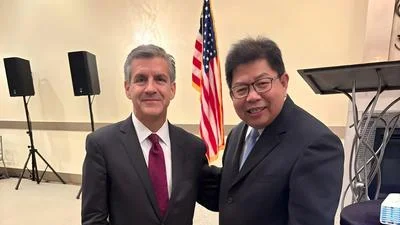Although it may have lost 47-0 against West Aurora High School on Sept. 8, there was still a victory of sorts for East Aurora High School, as the longstanding rivalry played out as the first game in a newly constructed, $7 million stadium.
The new facility represents another positive step forward for impoverished East Aurora, which didn’t even have school buses until this year, according to an Illinois Policy Institute article.
Residents are rallying around the improvements, which are seen as a way to equalize the economic disparity between the two halves of city, the institute said.

East Aurora High School
| Wikipedia
Aurora Mayor Richard Irvin, a 1988 graduate of East Aurora High, told the Illinois Policy Institute: “I graduated in 1988, and I can tell you that seeing this improvement at East Aurora High School, my alma mater. This is for the whole city.”
The school’s wrestling coach, Frankie Zepeda, told the Illinois Policy Institute, “It’s a breath of fresh air for the east side. For the kids, hopefully it’s motivation.”
Named for “goddess of the dawn” and more recently dubbed the “City of Lights,” Illinois’ second-largest city traces its roots to the 1834 settlement of New Yorker Joseph McCarty, according to the city’s website. The nearby Fox River powered the town’s textile and sawmills, allowing Aurora to attract other manufacturers, including rail-car and heavy equipment factories, over the years, City-Data.com reports.
The Fox River also created the physical separation between east and west, which at some point became an economic divide, the Illinois Policy Institute said. The city is 40 percent Hispanic, with much of the high minority population concentrated in the eastern half. Just two years ago, the U.S. Census Bureau reported the median earnings for the eastern half at $23,000, and categorized as low-income 75 percent of the students, according to data referenced in the institute’s report.
Joe Kaiser of the Illinois Policy Institute notes in a video shared on its Facebook page that “opportunity can sometimes be dictated by zip code” for the city’s residents.
Local resident Michael Fowler has seen the disparities first-hand. His black father and white mother raised him in the west side, but he is raising his family in the east, where his wife grew up.
“The east side, there’s always been more minorities or underclass," Fowler told the institute. "It’s always been less prominent than the west side. That’s been apparent in everything. From the way the streets look, to the way town is governed, to the school system.”
Although it is marked by poverty, East Aurora has thriving Hispanic businesses and organizations that have nonetheless strengthened the area economically.
Triple Threat Mentoring is an example of what the institute calls a “citizen-led” initiative to help the area improve. The non-profit group “uses passion to fight the cycle of poverty,” according to its website, and creates mentoring opportunities for area youths and adults around common interests.
“What it means to fight poverty with passion is to let everyone know there’s something they can do with the thing that they love,” Jordan Wilson, Triple Threat’s executive director of operations, said in a video interview with the institute. “There’s still a lot to be done, But the situation is definitely getting better.”
The institute cites the example of La Chicanita Bakery, a “sustainable, profitable business” launched by Mexican immigrants. From its multiple locations, the bakery has nurtured the community and routinely holds benefit drives for disaster victims.
Nancy Merlo, whose parents own the bakery, told the Illinois Policy Institute: “Sometimes [customers] come in, they’ve had a horrible day. They might have a rough time at home. They might come in saying that they’ve lost their job. Just being able to talk to them about that [is special].”
Some businesses even seem to ease the disparity by attracting customers from both halves of Aurora. According to the Illinois Policy Institute video, that’s the case with Banana Split, an ice cream shop Randy and Lisa Brown founded in 1983. Their three-flavor soft-serve offerings have fans among those who root for either the West Aurora or East Aurora football team and among all demographics.
“I grew up here, Randy and I,” Lisa Brown said in the video. “I always said we build memories, and ice cream is a great memory maker. Whenever you think of ice cream, you think of happy times.”






 Alerts Sign-up
Alerts Sign-up